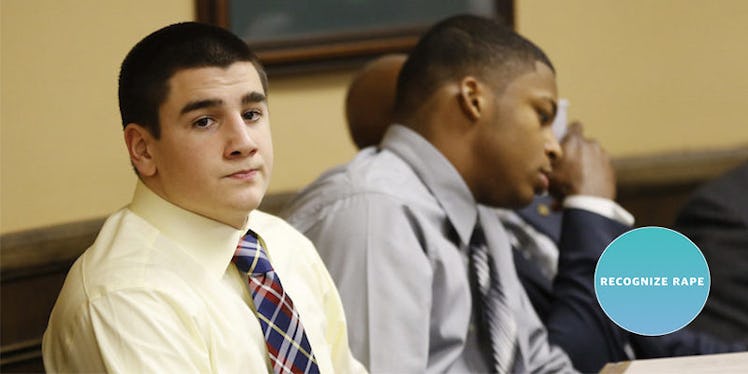
Everything That Happens After Sexual Assault Is Recorded On Social Media
Teenagers Trent Mays and Ma'lik Richmond raped a 16-year-old girl in Steubenville, Ohio in August 2012.
She was unconscious after drinking at a party. Other members of the Steubenville High School football team encouraged the rape. They took photos and videos.
The photos and videos were shared with friends and spread on social media, including Twitter and Facebook. Cody Saltsman, another football player, posted a photo on Instagram of the girl passed out and being carried by two other teenage boys.
The boys filmed a 12-minute conversation in which they joked about the rape. It was posted on YouTube. These photos and videos posted to social media were used as evidence in the case against Mays and Richmond.
In March 2013, they were found guilty of rape. Richmond went to juvenile detention for a year. Mays went for two years.
Mays' sentencing was longer because he had distributed a nude image of a minor, the New York Times reported.
Ari Waldman, professor and director of the Innovation Center for Law and Technology at New York Law School, told Elite Daily,
These cases are baffling in the sense that what these people are doing is broadcasting proof that they're committing a crime.
When a sexual assault is posted to social media, it can have unimaginable, hateful effects for the survivor, who is re-victimized by the social shares.
Especially during their teenage years, survivors have been bullied when evidence of their assault is spread on social media. Several girls, including Rehtaeh Parsons and Audrie Potts, committed suicide after this happened.
But when it comes to legal cases made against assailants, "it's great evidence for the victim," Waldman said.
It's not unusual for judges and juries to not believe survivors, Waldman explained. But when there's recorded evidence, it often helps to get assailants prosecuted.
These cases make up a small percentage of assaults, which are more often than not done without witnesses or recorded evidence. Plus, many assailants understand it's a really dumb thing to do, since it's clear evidence against them.
Sometimes, the social media evidence is missed if lawyers are not well-trained enough to collect it. But social media platforms do work with law enforcement to help get the evidence.
Facebook has a good relationship with law enforcement when it comes to reporting possible crimes and harmful incidents.
Anyone can report Facebook content if it violates standards. All it takes is one report for Facebook to review something, a spokesperson said.
On the flip side, multiple reports do not necessarily mean content will be taken down if a review does not find that it violates the standards.
Facebook's community standards include a section on "sexual violence and exploitation." That section says,
Where appropriate, we refer this content to law enforcement.
If there is an imminent threat – like violence being shown on Facebook Live – Facebook proactively contacts law enforcement.
These cases do happen. Memphis police investigated after a Facebook Live broadcast may have shown teens sexually assaulting an underage girl this August.
Between July and December 2015 (the most recent data available), Facebook gave law enforcement data 81 percent of the time when requested.
Although social media companies may be willing to comply (and proactively, too) when it comes to actual instances of assault, they are famously slower to react when it comes to harassment.
These platforms are not legally responsible for inappropriate content and harassment by users.
Not only can social media posts be key pieces of evidence in charging assailants with sexual assault, but they can also result in additional charges.
Like was the case with Mays, people can be charged for spreading images.
Waldman added,
If Barry commits a sexual assault of Alice, and Barry posts it online for everyone to see, then Barry may be convicted or go to trial for sexual assault – but Alice's family can also sue him for harassment or defamation or invasion of privacy for putting up the video which included her and made her the subject of other people's viewing without her consent.
Ultimately, posting photos or videos of sexual assault on social media shows a person's character and understanding of assault.
Young men may post evidence of rape online because they don't understand it's rape. They may also post it due to complete disrespect for women.
Waldman said,
Too many men don't think sexual assault is such a big deal. They're so blasé about it, they post it on Snapchat and social media.
Waldman explained it "shows you how devalued women victims' lives are to some people."
Citations: New York Times, National Domestic Violence Hotline, NBC